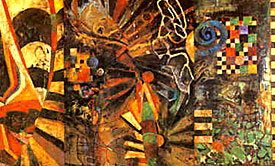 |
|
PHOTO COURTESY OF THE TUCSON MUSEUM OF ART
|
Terence La Noue's artwork is inspired by his visits to Africa, Morocco, India, Nepal and Central America. His textural paintings are layered with canvas, fabric, acrylic, paint and other objects.
|
|
By Biz Bledsoe
Arizona Daily Wildcat
Thursday March 13, 2003
Artist Terence La Noue's exhibit focuses on layers ¸ layers of material, layers of time and layers of cultures. What the layers divulge is four decades of bold and bright abstract work, brought together in the exhibition "Layers Concealed and Revealed."
"The exhibition is a rich sensation of color and line and movement," said Julie Sasse, the curator of contemporary art at the Tucson Museum of Art. "There's a deep sense of archaeology in the way that the works are layered. The way that La Noue creates the pieces is so that you can see all these wonderful layers of fabric or gauze or acrylic paint. It's a lively melding of many different materials, symbols, colors, and pure, expressive brush strokes."
The "Layers" exhibit, running now until May 18 at the Tucson Museum of Art, contains 34 works that range in size and medium, including 16 graphics. Beginning Sunday, there will also be several lectures with the artist, as well as hands-on artistic activities open to the public.
"There are 34 different works of art ranging from small works on paper to large-scale canvases 120 inches wide," Sasse said. "Some canvases are hung to emulate an actual tapestry."
There are four upcoming activities for the exhibition, two of which will showcase La Noue, which seems unusual for a feature exhibition of a prominent artist.
"The Tucson Museum really believes in the idea of community involvement in the exhibitions, and that there is a strong educational component to everything that we do," Sasse said. "People can have a little bit more awareness of what they're seeing and also an opportunity to meet the artist, because that's part of a very enriching experience."
La Noue's extensive world travels serve as inspiration for his works, which are often abstract mixtures of Western and non-Western traditions and histories. La Noue's travels take him to places like India, South America, Morocco, Mexico and Nepal, and his work can be seen all over the world, including Japan, Germany, France, New York and Chicago. He also exhibits frequently right here in Arizona.
"Layers Concealed and Revealed" came to the TMA as a result of La Noue's long-standing relationship with the museum, and his recent donation of a body of graphics to the museum's collection.
"This exhibition is meant to celebrate and highlight this rather extensive body of graphics that are now a part of our permanent collection," Sasse said.
Born in Hammond, Ind., in 1941, La Noue went to college originally intending to study psychology. He soon switched to art, however, and took up an interest in German expressionism. After he graduated, he received a Fulbright grant to study art in Germany, where he became fascinated by a trend called new critical realism. Upon his return, La Noue moved to Manhattan and became involved with post-minimalist art.
"He started out inspired by the German expressionists and the abstract expressionists, but then when he went to Germany he found a new movement, and upon returning to New York his work evolved again," Sasse said. "His work changed when he returned to New York, and of course the times were changing too."
In 1965, La Noue earned his M.F.A from Cornell and began to find his own artistic movement.
"Slowly he developed his own unique style that didn't follow any particular ╬-ism' or movement," Sasse said.
La Noue now frequently exhibits in Arizona and even has a studio south of Tucson, which might be unexpected given his extensive world travels.
"I think he's very taken with the land," Sasse said. "He refers a lot to Arizona in his paintings. What intrigues many artists is the quality of the light and the open expanses of the land. His work is influenced by his travels; he's traveled to many places, to Africa, to Morocco, South America, and India, all over the world. It's rather surprising that he came to the Southwest."

